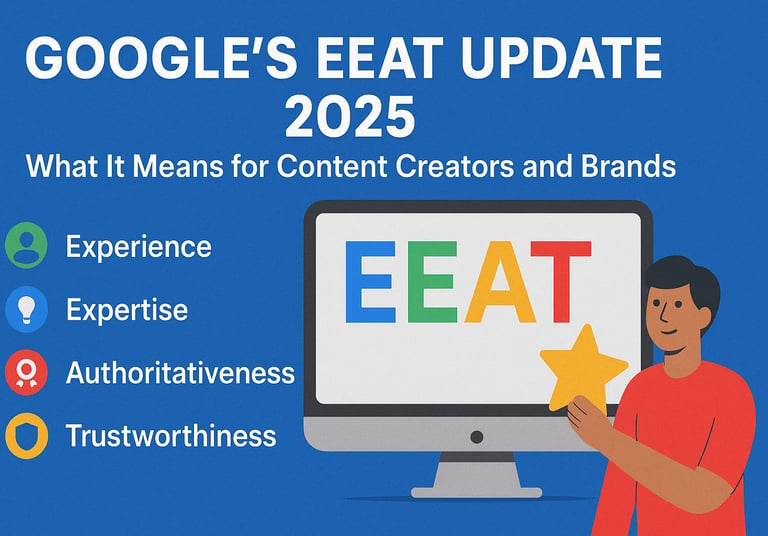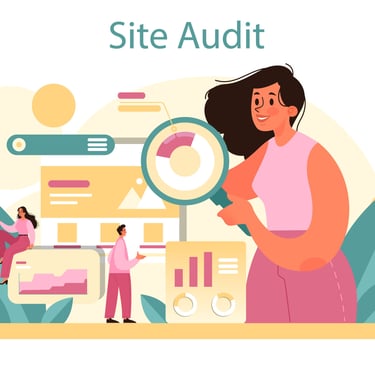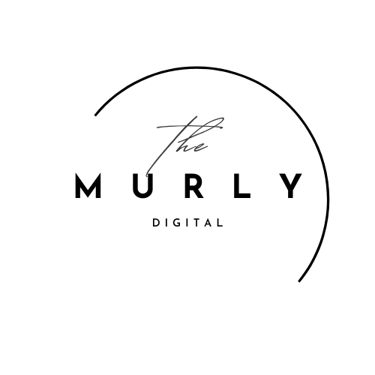Google’s EEAT Update 2025: What It Means for Content Creators and Brands
Google’s 2025 E-E-A-T update prioritizes content that demonstrates real Experience, Expertise, Authoritativeness, and Trustworthiness—pushing brands to shift from keyword-driven strategies to credibility-driven content that builds long-term trust.
9/18/20253 min read


Google’s EEAT Update 2025: What It Means for Content Creators and Brands
Introduction: Why E-E-A-T Matters Now More Than Ever
SEO has never been static. Each Google algorithm update redefines what ranks and why. The latest evolution—centered on E-E-A-T—has changed how brands must approach content marketing and search strategy.
This isn’t another minor SEO tweak. The Google E-E-A-T Update 2025 aligns digital content with human credibility signals. Google now prioritizes trustworthy content—backed by real-world experience, verified expertise, and authentic authority.
For content creators and brands, the message is clear: your digital presence must look, feel, and act credible.
1. Breaking Down Google E-E-A-T
E = Experience (First-Hand Authority)
Show real-world experience with the subject matter.
Example: A skincare review written by someone who has personally used the product ranks higher than a generic AI-generated post.
E = Expertise (Subject Knowledge)
Demonstrate verifiable subject knowledge.
Example: A finance article authored by a certified financial planner is more credible than a generic blog post.
A = Authoritativeness (Industry Recognition)
Be recognized as a reliable source within your industry.
Signals: Mentions, backlinks from reputable sites, guest contributions, media citations.
T = Trustworthiness (Credibility & Accuracy)
Ensure transparency, accuracy, and safety.
Signals: HTTPS, detailed author bios, citations, fact-checked data, positive user reviews.
Key Insight: Google doesn’t use a single “E-E-A-T score.” It evaluates multiple trust signals collectively to judge content credibility.
2. Why the E-E-A-T Update Matters for Brands
From Keywords to Credibility:
Keyword optimization alone no longer guarantees visibility. Brands must now prove legitimacy and reliability.
Filtering AI-Generated Noise:
As AI content floods the web, E-E-A-T acts as a quality filter—prioritizing content grounded in genuine expertise.
Impact on YMYL (Your Money, Your Life) Sectors:
Finance, healthcare, and legal industries face heightened scrutiny, but E-E-A-T principles apply across every niche—from SaaS to education
3. Key E-E-A-T Ranking Signals Google Uses
According to Google’s Search Quality Rater Guidelines, E-E-A-T is assessed through multiple indicators:
Author Bios & Credentials: Visible expertise and verified authorship.
Citations & References: Linking to trusted and authoritative sources
Content Accuracy: Use of recent statistics and fact-checked data
Reputation Signals: Positive reviews, PR mentions, and industry recognition.
Backlink Quality: High-value backlinks from reputable domains.
UX & Transparency: Secure HTTPS, clean navigation, and clear privacy policies.
4. How Brands Can Align With Google E-E-A-T
1. Showcase Real Experience
Add case studies, testimonials, and first-hand narratives.
Share original insights and internal data rather than generic summaries.
2. Elevate Expert Voices
Publish content from certified professionals.
Include bios, LinkedIn links, and verified credentials.
3. Build Industry Authority
Collaborate with known thought leaders.
Publish whitepapers, webinars, or event recaps on reputable platforms.
4. Optimize for Trust
Maintain technical SEO hygiene (HTTPS, fast load times).
Add transparent About pages and editorial policies.
Display customer reviews and verified trust badges.
5. Implications for Content Creators
For creators, the E-E-A-T framework raises the bar:
Balance SEO with human credibility.
AI tools can assist, but content must reflect personal experience.
Strengthen your personal brand—Google values recognizable expert bylines over faceless writing.
6. E-E-A-T in Industry Applications
Real Estate: Insights from licensed agents with verified client outcomes.
Consulting & Coaching: Thought-leadership posts with testimonials and actionable frameworks.
E-commerce: In-depth product reviews supported by authentic customer feedback.
Healthcare & Wellness: Articles written or reviewed by certified medical professionals.
Brands in India can especially benefit by showcasing verified regional expertise and publishing bilingual or localized content—enhancing trust with both Google and Indian audiences.
7. Measuring the Impact of E-E-A-T on SEO
E-E-A-T isn’t a direct ranking metric—but its influence shows through:
Improved Organic Rankings for expert-led pages.
Higher Engagement Metrics like time on page and scroll depth.
Backlink Growth from authoritative mentions.
Increased Brand Mentions across PR, forums, and review platforms.
Recommended Tools: Google Search Console, Ahrefs, Moz, SEMrush, Trustpilot, G2.
Final Thoughts: Trust Is the New SEO Currency
The Google E-E-A-T Update 2025 reinforces one truth: trust now drives visibility.
Brands must move beyond content volume and focus on credibility. Before publishing any piece, ask yourself:
Does this reflect real experience?
Does it demonstrate true expertise?
Does it position us as an authority?
Does it build trust with our audience?
Those who embrace E-E-A-T won’t just rank higher—they’ll earn lasting digital credibility and brand loyalty.



